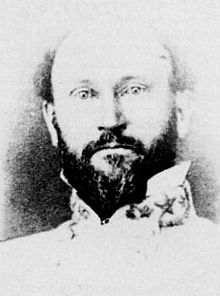“Old One Wing”
Another installment of the series “Tales From the Tombstone”
At the Battle of Churubusco on August 20, 1847, during the attack on the Franciscan Convent that was the focal point of the Mexican defenses there, one of the artillery battery’s commanders was struck in the right arm by grapeshot. The arm shattered, the brave young American gritted the now-empty sleeve between his teeth, relinquished command of the battery, and headed toward the rear.

He would survive and become a brigadier general in another war, this time fighting against the United States in the service of the Confederacy. His name was James Green Martin. Interestingly, the man he relinquished command of the battery to also was destined for fame in the Civil War: Thomas Jonathan Jackson.
Martin, born in Elizabeth City, North Carolina, attended West Point, graduating in 1840; he was one place behind another future Confederate general, Richard Ewell, who was 13th out of 42 graduates. Two other notable 1840 class members were William Sherman and George Thomas.
This began a long military career in which Martin served in Mexico, was brevetted to major (for his action during separate battles, including Churubusco), and then saw service from the tip of Virginia at Fortress Monroe, to Philadelphia, to the woods of Minnesota at Fort Snelling, and then in another war, the Utah War. Before beginning his assignments, he married Mary Ann Murray Read on July 12, 1844. She was a descendent of a Signer of the Declaration. Read died when Martin was stationed at Fort Snelling.
Martin remarried in 1858 to Hetty King, a sister of General Rufus King. While serving at Fort Riley, Kansas, the sectional crisis heated up.
Siding with his native North Carolina, Martin resigned his commission in June 1861 and offered his services to the Tarheel State. Initially in charge of organizing state forces, he applied for and was promoted to the rank of brigadier general in the provisional army in May 1862.
For the majority of 1862, Martin was in charge of the district of North Carolina. The following year, tasked with recruiting and organizing a brigade, Martin took the field and was stationed near Wilmington, North Carolina.
His brigade took part in the assaults on New Bern in February 1864. Called to the defenses of Petersburg, Martin and his North Carolinians was assigned to the division of fellow Tar Heel, Major General Robert Hoke. His men held a critical portion of the line at the Battle of Cold Harbor in early June 1864.
Shuttled back to the trenches of Petersburg, Martin’s health began to fail. New orders arrived to send him back to his birth state. This time duty called him to Asheville to command of the District of Western North Carolina.
While serving in this capacity, Martin surrendered his forces and the district to Union forces in Waynesville, North Carolina on May 6, 1865. His men were the last organized Confederate forces to surrender in the Old North State.
One of the most fitting attributes to “Old One Wing,” as he was affectionately known by troops under his command, was spoken by Robert E. Lee: “General Martin is one to whom North Carolina owes a debt she can never repay.”

In talking about debt, the immediate aftermath of the war left Martin in dire financial straits. He went back to the books, this time studying for the bar, which he was admitted to. He practiced law in and near Asheville, North Carolina, until his death on October 4, 1878. He was 59 years old.

Martin is buried at Riverside Cemetery within the city limits of Asheville, along with a few other general officers and North Carolina’s wartime governor, Zebulon Vance.